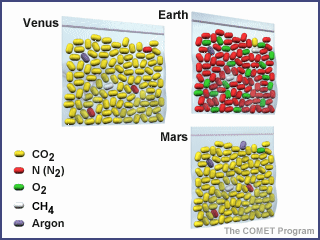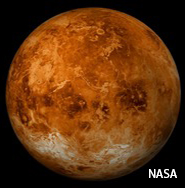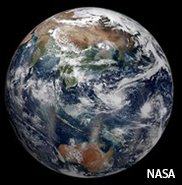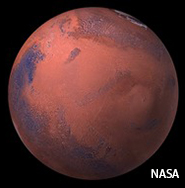Comparing Planetary Gases
In this activity, students learn about the atmospheric differences between the three "sister" planets (Venus, Earth, and Mars) by developing and using models of the atmospheric compositions of the three planets. Students will understand the scope and importance of the greenhouse effect on Earth.
Learning Objectives
- Students will understand that Earth's two closest neighbors, Venus and Mars, have very different atmospheres than the Earth.
- Students will be able to explain the "Goldilocks Principle" and understand that Earth's moderate temperature is due primarily to its unique atmosphere.
Materials
- Colored jellybeans, cotton balls or different colored beans (or similar materials) to represent different gases in the atmosphere of each planet
- Re-sealable plastic bags
Preparation
- Teacher hands out three small, re-sealable bags to each pair or team of students.
- Teacher provides each team of students with a total of 300 jellybeans (100 for each planet). Use Table 1 (below) to determine how many jellybeans of each color for each of the three planets. For example,Earth's atmosphere consists of 78% nitrogen; therefore, 78 out of the 100 jellybeans are one color.If you are unable to provide 300 jellybeans, you can use a smaller number and adjust the proportions. Depending on the math skills of your students, you may need to help them with adjusting percentages to represent the proper number of beans.
Directions
Note: Younger grades might enjoy the model construction but may have difficulty translating the abstract model into an understanding of the real atmospheres.
- Introduction
- Discuss greenhouse gases and the greenhouse effect. Refer to background section and to Tables 1 and 2 found in the Tables Section below.
- Ask students "Why do you think living organisms thrive on Earth but not on Venus or Mars?"
- Discuss the "Goldilocks Principle" and how the Earth has just the right amount of greenhouse gases to keep Earth just the right temperature for living organisms.
- Tell students (in teams or pairs) that in this activity they will build models of the atmospheres of Earth and the other planets. Emphasize that models are critical tools for planetary scientists trying to understand phenomena too distant to experience directly.
- Depending on the material available, ask students to represent the atmospheric gases with different colored beans, cotton balls, or jelly beans. We will use jellybeans in this activity.
Example:
 Nitrogen (N2) with red jellybeans
Nitrogen (N2) with red jellybeans- Oxygen (O2) with green jellybeans
- Argon (Ar) with purple jellybeans
- Carbon dioxide (CO2) with yellow jellybeans
- Methane (CH4) with white jellybeans
- Challenge the students to produce a model atmosphere for each planet by placing the appropriate number of each color of jellybeans in each of three small, re-sealable plastic bags. The fraction of each different gas in the atmospheres of Venus, Earth, and Mars is provided in Table 1 below. For additional information, refer to the Preparation section. Students will have to translate percentages into numbers of jellybeans, and in many cases, will face the difficulty of cutting the jellybeans into small enough pieces to represent small atmospheric concentrations.
- Have students explain what they found to the class.
Tables needed for activities
Table 1
The table below lists the atmospheric factors responsible for the planetary differences. The relative distance from the Sun influences planetary temperature, but the greenhouse gases and atmospheric density also have a large impact on surface temperature. Venus has an extremely dense atmosphere (with a surface pressure more than 90 times Earth's). Conversely, Mars has an extremely thin atmosphere (with a surface pressure less than 1/100th of Earth's).
 |
 |
 |
|
| Venus | Earth | Mars | |
| Carbon Dioxide (CO2) | 96.5% | 0.03% | 95% |
| Nitrogen (N2) | 3.5% | 78% | 2.7% |
| Oxygen (O2) | Trace | 21% | 0.13% |
| Argon (Ar) | 0.007% | 0.9% | 1.6% |
| Methane (CH4) | 0 | 0.002% | 0 |
Table 2
The chemical compositions of the atmospheres are important, especially in determining suitability for life. The major greenhouse gases (GHG) and their percentages are listed below.
 |
 |
 |
|
| Venus | Earth | Mars | |
| Surface pressure relative to Earth | 92 bars | 1 bar | 0.006 bar |
| Major greenhouse gases (GHG) | CO2 | H2O and CO2 | CO2 |
| Temperature if no GHG | -47° C (-52° F) | -19° C (-2° F) | -63° C (-82° F) |
| Actual Temperature | 464° C (867° F) | 15° C (59° F) | -63° C (-82° F) |
| Temperature change due to GHG | +511° C (919° F) | +34° C (61° F) | +0.2° C (0.4° F) |
Note: Earth's atmosphere always has some water vapor in it; on a humid day, water vapor can account for more than 2% of the atmospheric gas in a specific place. However, the average amount of water vapor in Earth's atmosphere is around 1%. To make things simpler, scientists often refer to Earth's dry atmosphere, meaning all the gases except for the variable amount of water vapor. In this "dry atmosphere", nitrogen and oxygen comprise almost 99% of the gases in Earth's atmosphere. The remaining trace gases add up to less than 1% of Earth's dry atmosphere. The totals for each planet in Table 1 do not add up to exactly 100% because not all of the trace gases have been listed.
Assessment
- Have the students display their work in the classroom and allow time for them to observe and discuss each other's work as you circulate.
- Have students respond in writing to the following questions:
- Describe the atmospheric conditions you might encounter as an astronaut setting foot on Venus and Mars.
- Name at least two ways that the atmospheres of Venus and Mars are similar to each other, and one way that both differ from Earth's.
- What new information did you learn in this lesson? What did you already know? What was the hardest thing about the activity?
Background
Greenhouse Gases
On Earth, two elements, nitrogen (N2) and oxygen (O2), make up almost 99% of the volume of clean, dry air. Most of the remaining 1% is accounted for by the inert gaseous element, argon (Ar). Argon and the tiny percentage of remaining gases are referred to as trace gases. Certain trace atmospheric gases help to heat up our planet because they appear transparent to incoming visible (shortwave) light/radiation but act as a barrier to outgoing infrared (longwave) radiation. These special trace gases are often referred to as greenhouse gases which are heat-trapping gases that radiate the heat back to the Earth's surface, to another greenhouse gas molecule, or out to space.
The major greenhouse gases are carbon dioxide (CO2), water vapor (H2O), methane (CH4), and nitrous oxide (N2O). These greenhouse gas molecules all are made of three or more atoms. The atoms are held together loosely enough that they vibrate when they absorb heat. Eventually, the vibrating molecules release the radiation, which will likely be absorbed by another greenhouse gas molecule. This process keeps heat near the Earth’s surface and contributes to the greenhouse effect.
Greenhouse Effect
Plants, animals, and humans are able to live and thrive on Earth because the conditions in our atmosphere are just right. Earth’s atmosphere acts like a blanket, keeping the temperatures from being too hot or too cold for living organisms. Without the greenhouse effect, Earth’s average temperature would be roughly -19° C (-2° F), well below freezing, instead of the current comfortable 15° C (59° F).
We can evaluate the effect of greenhouse gases by comparing Earth with its nearest planetary neighbors, Venus and Mars. These planets either have too much greenhouse effect or too little to be able to sustain life as we know it. The differences between the three planets have been termed the "Goldilocks Principle". The "Goldilocks Principle" refers to the fact that Venus is too hot, Mars is too cold, but Earth is just right.
Mars and Venus have essentially the same types and percentages of gases in their atmosphere. However, they have very different atmospheric densities.
- Venus has an extremely dense atmosphere and many more greenhouse gases than Earth. The concentration ofCO2is responsible for a "runaway" greenhouse effect and a very high annual average surface temperature of 464° C (867° F).
- Mars has a very thin atmosphere, and therefore very small amounts of greenhouse gases compared to Earth; so even though the atmosphere of Mars is mostly CO2, there is so little of it that it does not warm Mars very much and the annual average surface temperatures are quite low at around -63° C (-82° F).
- Mars is much further away from the Sun than is Venus.
Extensions and Variations
- Extension Activity: Take one set of bags and distribute the contents in areas measured to represent atmospheric pressure of each planet. For example, the jellybeans representing Earth might be distributed in a meter square. You might have to go outside to find an area big enough to represent the thin atmosphere found on Mars. To concentrate the beans representing the dense atmosphere of Venus, you could use a food processor or mortar and pestle to concentrate the jellybeans.
- For Advanced Students:To increase the difficulty of math, repeat activity with less than 100 jellybeans per planet. For example, hand out 10, 20 or 50 total jellybeans instead 100 for each planet.
Modifications for Alternative Learners
- Students who have difficulty with math concepts should be paired with students strong in math to avoid frustration with the fractions.
- Students with language difficulty should be assisted directly at the beginning of the model-building to make sure they understand the instructions.
Related Resources
- The Greenhouse Effect
- Greenhouse Gas Teaching Box Simulations
- Greenhouse Gas Board Game: Using Play to Learn Complex Concepts (for upper elementary and middle school)
- Earth's Radiation Budget
- Atmospheric gases: Nitrogen, Oxygen, Carbon Dioxide, Methane
- Earth's Energy Balance: Interactive & Calculation